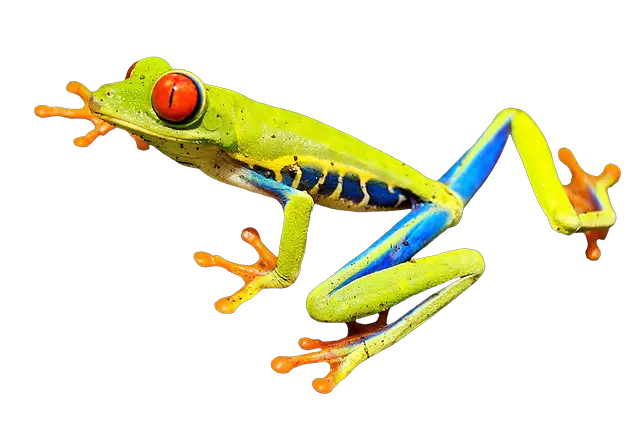The red-eyed tree frog is a striking little fella with an electric green body and cranberry red eyes. The colors don’t stop there with their pumpkin slippers and sapphire blue legs – they’re a complete mosaic. And for the experienced amphibian-owner, they make great pets.
Proper care and attention are critical for the health of these unique frogs. As any good caretaker might ask, is my red-eyed tree frog healthy? Let’s discuss how to assess the wellness of your pet.
Is my Red-eyed tree frog Healthy
Hailing from Central and South America, these tree frogs are widely known across the world, thanks to their iconic appearance. They are rainforest dwellers and thrive in temperatures between 75-85 degrees Fahrenheit.
These little night-owls are active under the moonlight and prefer to spend their day hours in slumber on leaves. The red-eyed tree frog is a socialite, so it’s best to keep a few together!
They can grow up to 3” long and live as long as 10 years!
Regularly inspect your red-eyed tree frog for good health. Read about the differences in a healthy versus unhealthy frog below.
Healthy:
- Eating regularly
- Their coloring looks bright and vibrant
- Maintaining natural nocturnal activity and daytime sleep cycle
- Moving easily, limbs move equally while crawling
Unhealthy signs:
- White or gray spots on frog: a sign of an illness known as Oodinium
- Caused by: a dirty environment or a secondary condition for another illness.
- Treat it: Move your frog into a very shallow dish of distilled water and give their tank an extensive cleaning.
- Legs and abdomen turn red: a sign of Red Leg Disease
- Caused by: bacterial or parasitic infection
- Treat it: visit your vet for a prescription of an antibacterial bath solution
- Slow and lethargic: a sign of malnutrition
- Treat it: you must supplement your frog’s meals by dusting them with a vitamin powder.
- Bloating: a sign of edema
- Caused by: bacterial infection or vitamin toxicity
- Treat it: soak your frog in distilled water for a few hours. If symptoms do not dissipate, see your vet because the bloating may be due to vitamin toxicity and this is fatal.
- Frog isn’t eating or jumping: could be Metabolic Bone Disease
- Caused by: malnutrition – a lack of vitamin D and calcium
- Treat it: contact your vet!
- Cloudy or smoky eyes: a sign of Cloudy Eye Syndrome
- Caused by: trauma to the eye
- Treat it: contact your vet.
[su_box title=”Our Red-eyed Tree Frog Guide”]You asked the question “Is my red-eyed tree frog healthy” Although we have answered your question in this article there may be other questions that you may have. To have all of those queries answered and to make sure you are caring for your frog correctly just click here to have a look at our tree frog guide. If you want to save money on buying those crickets you can go here to see our Cricket Breeding Guide.[/su_box]
Proper care
To ensure prime health in your frog, you’ve got to set up the best environment!
Tank setup
The tank should replicate their native grounds of the tropical rainforest by way of a vertical terrarium. So, lots of climbing structures, heat, and humidity. Here are the basics of what you want in your tank:
- Branches or logs for climbing and exploring
- Plants and greenery for the green frog to camouflage in, like they would in the wild. Live plants are extra special.
- Heater to replicate the warmth of the tropics
- Shallow water dish to provide extra humidity and a bath/drink
Climate
Keep it toasty around 80deg during the day and 72deg at night. Control your temperature with a basking lamp or heating pad and be sure to provide lots of bright light during the day and darkness at night.
Humidity should be kept around 60% by misting at least a few times a day and hit 90% once a day with a very thorough misting. A tool called a hygrometer thermometer will allow you to observe both the temperature and the humidity of your tank.
Feed
Red-eyed tree frogs can eat a varied diet of insects, but yours might be quite picky. A few crickets a day is all a frog needs. You’ll also want to supplement by dusting their food with calcium and vitamins.
Handle
These delicate creatures are best left for observing. They’re quite fragile and their permeable skin is very sensitive. If you need to handle your frog for some reason, be sure to thoroughly wash your hands before touching them.
When you notice signs of poor health
If the symptoms are treatable at home, do not delay. Red-eyed tree frogs are very sensitive and can only thrive if they are in good health and their environment is pristine!
The vet isn’t just for emergencies. Your tree frog should be making regular visits to the reptile veterinarian to make sure they are doing well. You can locate a local reptile vet near you by contacting the Association of Reptilian and Amphibian Veterinarians (www.ARAV.org).
Conclusion
Though they aren’t difficult to care for, these exotic pets do require specific conditions. For this reason, it’s an unfortunate truth that many domestic red-eyed tree frogs find their demise at the hands of inexperienced owners.
Understand that owning a red-eyed tree frog is an honor. Provide them with excellent care and treat health issues immediately to ensure your frog lives a long and prosperous life!




